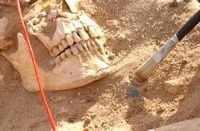In the bitter winter of 1812, as Napoleon Bonaparte’s Grande Armée limped away from Moscow, history recorded a catastrophe of epic proportions. Nearly half a million soldiers had marched into Russia; fewer than 50,000 would survive the retreat. For generations, historians and scientists alike have sought to understand what truly decimated this once-mighty force. While the freezing cold and hunger have always been cited, infectious disease has long been suspected as a silent killer. Now, a groundbreaking study published on October 24, 2025 in Current Biology is turning centuries-old assumptions on their head.
The new research, led by Dr. Nicolás Rascovan of the Institut Pasteur in France, analyzed ancient DNA from the teeth of 13 French soldiers found in a mass grave in Vilnius, Lithuania—a site discovered in 2001 along the infamous retreat route. Using advanced next-generation sequencing technology, the team set out to identify which pathogens might have contributed to the army’s downfall. Their findings? Not the expected culprits of typhus or trench fever, but rather two other formidable foes: Salmonella enterica and Borrelia recurrentis.
For decades, the prevailing theory was that typhus, a louse-borne disease caused by Rickettsia prowazekii, played the primary role in the disaster. This was supported by historical accounts from army doctors, the discovery of body lice on remains, and a 2006 DNA study that detected typhus and trench fever pathogens in other soldiers’ teeth. However, as Rascovan explained to Current Biology, “It’s very exciting to use a technology we have today to detect and diagnose something that was buried for 200 years.” Their use of next-generation sequencing allowed them to cast a much wider net, capturing even the tiniest fragments of ancient genetic material that older PCR-based techniques might have missed or overlooked entirely.
So what did they find? Of the 13 soldiers’ teeth analyzed, four samples tested positive for a subspecies of Salmonella enterica, the bacterium responsible for paratyphoid (enteric) fever—a disease spread through contaminated food and water, notorious for causing high fever, fatigue, and digestive distress. Two other samples revealed the presence of Borrelia recurrentis, which causes relapsing fever, a disease transmitted by body lice. Both illnesses would have left already weakened soldiers even more vulnerable to the merciless Russian winter and the relentless march home.
“There were not one or two, but many infectious diseases that were affecting these people,” Rascovan told Chemical & Engineering News, emphasizing the complexity of the medical disaster. His colleague, Rémi Barbieri, added, “We have to be very aware about the limitations of the study. If you’re looking for cholera, you can’t find cholera because [the pathogen that causes it] is only in the gut.” Their analysis was limited to blood-borne pathogens preserved in dental pulp, meaning other diseases—like cholera or tuberculosis—could have gone undetected.
Interestingly, the team didn’t find any trace of typhus or trench fever DNA in these particular samples, contradicting earlier studies. The researchers suggest that differences in detection methods may explain the discrepancy. “Ancient DNA gets highly degraded into pieces that are too small for PCR to work. Our method is able to cast a wider net and capture a greater range of DNA sources based on these very short ancient sequences,” Rascovan explained in his interview with Cell Press.
The study’s findings have far-reaching implications. Not only do they challenge the long-held belief that typhus was the main infectious agent responsible for the army’s demise, but they also highlight the power of modern paleogenomics to rewrite history. As Dr. Rascovan put it to VaccinesWork, “This shows the power of ancient DNA technology to uncover the history of infectious diseases that we wouldn’t be able to reconstruct with modern samples.”
What’s more, the Borrelia recurrentis strain identified in the soldiers’ teeth matched a lineage previously found in ancient Britain from the Iron Age, over 2,000 years earlier. This remarkable continuity suggests that some disease strains can persist quietly in human populations for millennia, only to resurface in times of crisis or upheaval. “It helps us to understand how infectious diseases evolved, spread, and disappeared over time, and to identify the social or environmental contexts that played a part in these developments,” Rascovan noted.
But the researchers are careful to acknowledge the limits of their work. With only 13 samples from a single grave, it’s impossible to determine the full extent or distribution of these pathogens across the entire army. “We can’t really know how widespread these pathogens were in this [mass death] event,” Rascovan admitted to Chemical & Engineering News. Further analysis would require destroying more ancient remains—a decision not taken lightly by scientists mindful of preserving history for future generations.
The study’s publication has drawn praise from experts in the field. Geneticist Carles Lalueza-Fox, who has studied similar pathogens in Spanish soldiers from the 17th century, told Live Science, “It emphasizes how the history of past pathogens and epidemics is inextricably linked to history, especially to military history, past migrations, and colonization processes. It is likely that, in the past, more soldiers died of disease than fighting.” He added that advances in biology and archaeology are now providing crucial new details about the human stories behind historical events: “Epidemics had an impact not only in mortality, but also in social, political and even cultural aspects.”
Indeed, the story of Napoleon’s doomed retreat is not just one of military miscalculation or the brutality of winter. It’s a reminder of the invisible enemies—disease and exhaustion—that have shaped the fate of nations. The soldiers’ suffering was compounded by relentless snowstorms, starvation, and the collapse of morale. Survivors recounted eating horses, dogs, and even tree bark, while many simply froze after collapsing from exhaustion. The new study suggests that as these men staggered westward, they were also battling waves of fever and infection, their bodies ravaged by pathogens as well as the elements.
“A reasonable scenario for the deaths of these soldiers would be a combination of fatigue, cold, and several diseases, including paratyphoid fever and louse-borne relapsing fever,” the researchers wrote in Current Biology. Their work, supported by the European Research Council and several French institutions, opens the door for future studies that may further unravel the tangled web of factors behind one of history’s greatest military disasters.
The collapse of Napoleon’s Grande Armée is a story often told in terms of frostbite and failed logistics. Now, thanks to the silent stories hidden in ancient teeth, we see a fuller, more complex picture—one where disease, as much as winter, dictated the fate of an empire.


